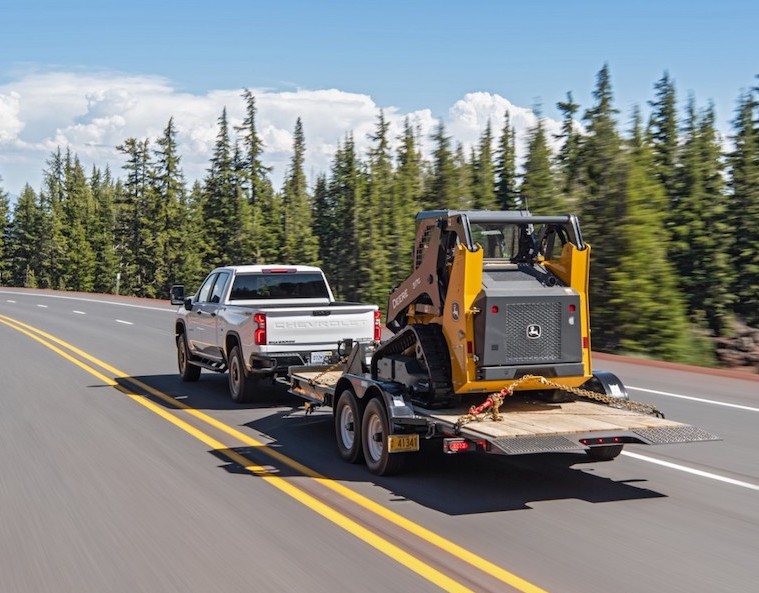Work Truck Trailering

Trailering behind vocational trucks is often taken for granted. For instance, Class 8 drivers in over-the-road and less-than-truckload applications tend to experience fewer loading issues specific to the towing vehicle simply because their natural operating state is with a trailer. In contrast, with vocational drivers who occasionally use trailers (often different types with varying loads and configurations), there are more opportunities for mistakes.
Couplings for commercial motor vehicles are regulated under Federal Motor Carrier Safety Regulations (FMCSR) Part 393.70, and coupler performance requirements are covered under various SAE Standards, such as J684, J847 and J2638.
Four central issues can impact occasional trailer towing.
- Are you exceeding truck gross vehicle weight rating (GVWR) and/or gross axle weight ratings (GAWRs), including the effect of trailer tongue weight as part of the weight analyses?
- Are you using the right type of trailer with the right connection to the towing truck?
- Are you overloading the trailer?
- Are you using the correct load distribution on the trailer to ensure safe towing characteristics?
How much can it really tow?
Commonly held towing beliefs include the notion that if it moves, it’s not overloaded, and if the front wheels are on the ground, it’s good to go. These statements have the potential to create critical problems for fleet operations.
Design criteria on capacity limits is key to understanding conventional towing and truck load capability. Typically, vehicles through GVWR Class 4 — 14,001–16,000 pounds — are assigned a maximum trailer weight rating by chassis manufacturers. However, several OEMs expanded manufacturer tow ratings through Class 6. Tow ratings for Class 5 and larger trucks may not normally be provided by the OEM, even though they also have limits that are a function of design criteria. Regardless of class, actual towing capacity is based on multiple factors. It’s important to understand two trucks identical in appearance can have different tow ratings.
Major components of tow capacity are
- OEM maximum trailer weight rating (TWR)
- Gross combined weight rating (GCWR)
- GAWRs
- GVWR
- OEM powertrain and rear axle combination
- Hitch rating
TWR
When specified by the chassis OEM, TWR is the maximum trailer weight a specific truck model can tow. This maximum weight includes the combination of the trailer and its load. Note, this value comes from the chassis OEM, based on its determination of the vehicle’s capability. It should not be confused with trailer GVWR, which is assigned by the trailer manufacturer.
GCWR
GCWR is the maximum allowable weight of a combination vehicle at the ground with a trailer or trailers, including vehicle, equipment, driver, passengers, fuel and payload (essentially, everything that moves with the vehicle and trailer). Regardless of TWR, the combined weight of the towing vehicle and loaded trailer cannot exceed GCWR. A vehicle’s GCWR is a limit determined by the towing vehicle manufacturer to be the maximum weight of a loaded tow vehicle and its attached, loaded trailer. So, when the truck is loaded with more passengers and/or cargo, the trailer must weigh less to stay within this rating.
Remember, GCWR is not an actual measurement of the weight of a tow vehicle and trailer, but rather, the combined maximum weight limit set by the manufacturer for the two vehicles once attached.
Tow vehicle GAWR
GAWR is the value specified by the vehicle manufacturer as the load-carrying capacity of a single axle system, as measured at tire-ground interfaces. Towing vehicle GVWR and GAWR are listed on the certification label; however, TWR and GCWR must be located from other sources, such as an owner’s manual or OEM trailer towing guide. Vocational trucks (more prominently than Class 1–5 vehicles) can be axle weight limited. And in specifying trucks, particularly for towing configuration, rear axle rating is critical. Not only do you need to pay specific attention to towing truck load design, but as a properly attached trailer puts downward pressure on the tow hitch (often referred to as tongue weight), this adds to rear axle weight.
Towing vehicle total weight must include the effect of trailer tongue weight and cannot exceed the GVWR or GAWRs, especially that of the rear axle. When designing or upfitting a vehicle, it’s important to take weight distribution into consideration. NTEA members can access Vehicle Center of Gravity and Axle Weight Calculator (login required). This tool can aid in design to ensure rear axles are properly specified when adding a trailer.
Hitch rating
Trailer hitches normally have two ratings. First is tongue weight rating or maximum allowable vertical load capacity the hitch can safely support. Second is trailer weight or maximum allowable total weight of the trailer connected by the hitch. Hitch ratings stamped on a hitch or hitch component are often higher or lower than what the OEM prescribes as allowable for the vehicle. It’s important to check both and follow the lower allowed value(s) for total trailer and tongue weight. Regardless of hitch ratings, final weight restrictions can be affected by attachment type and installation technique.
Attachment types
While there are a variety of trailer attachments, these examples include some of the most common types. As shown on this page, each hitch type has weight limits that must be mated to trailer and truck towing capacities. It’s possible to mismatch the practical application of one of these hitches and incorrectly load a heavy trailer beyond the limit of the truck’s load capacity. These attachments are regulated under FMCSR Part 393.70, which also includes requirements for safety devices and their attachment. Make sure drivers or others who connect trailers are informed on proper operation of hitch and coupler mechanism(s), safety device attachment, and sizing compatibility between truck hitch and trailer coupler. Even slight misinformation on operating characteristics can lead to trailer disconnect.
Safety devices, such as chains, cables or other secondary attachments between the trailer and towing vehicle are essential to a safe operating scenario. Drivers should be trained to cross chains under the trailer for attachment to the truck (this routing allows for turning slack without dragging). More than one trailer has been safely stopped as a result of properly attached safety chains when the hitch connection has separated from the towing truck. Operators should be encouraged to review safety chain attachment and attachment points as a final step before entering towing activities.
This review can be performed while trailer light connections are tested for correct functionality, including brake lights, turn signals and visible lighting when truck lights are engaged. If brakes are featured on your trailer, this can be checked in a few ways, depending on which systems are present. Ensure electric brakes are correctly plugged in and the trailer emergency battery is functional and charged.
Design preparation
Once basic measures and limiting factors are understood, other elements must be noted. As previously mentioned, several questions need to be addressed to help ensure a safe, reliable and regulatory compliant trailer solution.
Initially, which trailer design is right for a fleet? Begin by examining the combination of specifications required of both tow vehicle and trailer. For example, does the trailer need to be covered or can it be open? What size is the tow vehicle (light-duty, heavy-duty, cargo van, etc.)? What type and weight of cargo will the trailer transport? In fact, trailer payload needs and load type are often the start of determining which trailer is needed and then which truck to choose, including hitch system availability or selection. If you require high payloads or specific equipment to haul on the trailer, this reverse process can be critical to meeting needs.
It’s important to note most trailers can unknowingly be loaded well beyond rated capacity with potentially disastrous consequences.
Taking control of the trailer
As previously mentioned, the trailer, attachment and towing vehicle have design limits. Ultimately, though, the operator and person loading the trailer are responsible for safe, successful operation of the trailer and towing truck combination. Beyond correct load procedures, including proper load securement, the driving experience with a towed trailer can be distinctly different, requiring skills not normally used when driving without a trailer.
The most important thing a driver can do to ensure safe and efficient towing vehicle trailer operation is to evolve driving style and attitude to accommodate for some element (or combination thereof) of the vehicle being driven. For example, the trailer is behind the primary vehicle, so the driver must adjust for scenarios such as changing lanes. This will ensure enough room for safe clearance.
Training for this driving style may sound difficult, but once the driver starts accounting for differences in overall vehicle size (and length) and other situationally specific behaviors, appropriate driving skills can become second nature. When operating a manual transmission, for instance, certain driving techniques change on hilly terrain versus flat. While all drivers and operators should be driving in a safe manner, it’s still important to adjust behaviors when towing trailers. Awareness training when towing is essential for safe trailering operations.
Capacity and loading
Small, seemingly insignificant details can play a serious role in overall design and operation. Remember, true towing capacity is limited by the lightest link in the total vehicle assembly. Tires and axles may seem obvious, but drivetrain and frame strength play a vital role in determining if selected truck and trailer combinations are complementary.
Just because the attachment points fit does not mean the towing vehicle has the power and braking capacity to safely execute the operation. As shown in the illustrated examples, several of these hitches can handle multiple sizes and types of trailers. Note, all coupling system components should be reviewed individually for weight ratings. For instance, if the pintle hitch is rated for 30,000 pounds and the receiver tube is rated for 20,000 pounds, it’s critical to understand the receiver tube is the limiting factor in this example.
In field operations, it can be difficult for operators to easily estimate trailer load weights. With tool carrying trailers, loads tend to be relatively static and can be managed by constructing an interior trailer package that makes it easy for users to properly store material carried on the trailer. It also simplifies the task of distributing weight when there is a designated place for load components.
Trailer whipping will likely occur at higher speeds if a trailer is loaded heavier in the rear half. This is uncontrollable as violent sway occurs naturally at a certain speed for an improperly loaded trailer. Trailer users need to be educated on this topic. Whether you have the role of fleet professional, salesperson, upfitter or dealer, it’s your responsibility to help drivers or end users focus on safe and effective loading practices, even if it requires a second or third visit to the worksite to recover all returned material.
More challenging, however, are trailers hauling return loads from the work site. Spoil from excavations can vary significantly in weight depending on waste material composition (rock or concrete versus dirt and construction debris like wood and drywall). For poles and fence construction material, it’s easy to overload and/or create an improperly distributed load.
Another challenge owners, fleet operators and end users must address is ensuring driver/operator training is current and regularly updated so the right behaviors become routine. While in the distribution market, it’s important to educate customers and users. As we know, the weakest link is always the limiting factor. It’s essential to know safety chain ratings and to make sure they’re routinely inspected for condition and wear. All attachment points need to be inspected and correctly sized, including S hooks and D rings.
The final inspection point for trailers is to ensure there are no cracks or broken welds in the hitch system assembly and joints between the trailer frame and towing assembly. The good news is, a careful visual inspection will generally reveal problem spots in these areas. Trailers often have service life expectations that exceed the trucks towing them. Consequently, periodic review of the trailers for metal fatigue and structural damage should be more frequent as their service life increases. Don’t hesitate to add trailers to preventive and predictive maintenance routines to help guard against field failures. For trailers with a long service life, using a professional inspection company to evaluate welds and metal fatigue in later years of the equipment’s useful service life can go a long way in preventing significant failure events.
Components may look the same, but are they?
While proper trailer design is crucial, the details play a key role. With so many complex components, it’s mission-critical to understand a single component can be the limiting factor. While components (or replacement wear parts) may look the same, they may not be identical. Take extra time to ensure the weakest link is understood. This can be gross combination weight, coupler rating, axle capacity or something as small (but not insignificant) as the hardware used to bolt everything together. This, by definition, is the final limiting factor for maximum towing capacity.
This article was written collaboratively byNTEA Fleet Relations and Technical Services Departments, with special contributions fromJames D. Fait, P.E.,U-Haul Engineering Services.
NTEA offers access to publications and reference materials on current regulations, safety standards, and other technical issues at ntea.com. To learn more about the tools, resources and solutions available to members, visit ntea.com/memberbenefits.
GTA, an NTEA affiliate division, offers a variety of resources to educate its members on techniques and technology that can improve fleet efficiency, reduce emissions across time, and lower the risk of fuel price volatility driving up operating expenses. GTA fleet members can get involved in the data logger drive and duty cycle program that provides information on how vehicles operate in varying environments; find details at greentruckassociation.com.
Established in 1964, NTEA – The Association for the Work Truck Industry represents more than 2,200 companies that manufacture, distribute, install, sell and repair commercial trucks, truck bodies, truck equipment, trailers and accessories. Buyers of work trucks and the major commercial truck chassis manufacturers also belong to the Association. NTEA provides in-depth technical information, education, and member programs and services, and produces The Work Truck Show®. The Association maintains its administrative headquarters in suburban Detroit and government relations offices in Washington, DC, and Ottawa, Ontario. NTEA staff are knowledgeable and experienced in a variety of areas related to the work truck industry. Visit ntea.com/meetourexperts to learn more or request an interview.
Photo: 2020 Chevrolet Silverado 2500 HD Custom. Photo provided by Chevrolet.


